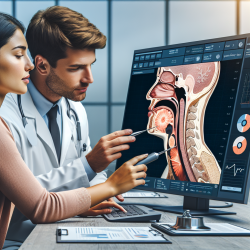Introduction
In the realm of speech-language pathology, the precise measurement of pharyngeal residue is crucial for diagnosing and managing dysphagia. The research article titled "Measurement of Pharyngeal Residue From Lateral View Videofluoroscopic Images" offers valuable insights into improving measurement accuracy and reliability. This blog aims to guide practitioners in implementing these findings to enhance their skills and encourage further research in this critical area.
Understanding Pharyngeal Residue Measurement
The study explores four distinct methods for measuring pharyngeal residue using videofluoroscopy:
- The visuoperceptual Eisenhuber scale
- Pixel-based methods such as the %-Full measure
- The Normalized Residue Ratio Scale (NRRS)
- Residue area divided by a cervical spine scalar (%(C2–4)2)
Each method has its own merits and limitations, but the study highlights the importance of pixel-based measurements for their precision and reliability.
Key Findings and Recommendations
The research underscores the effectiveness of pixel-based measurements using an anatomical reference scalar, such as the %(C2–4)2 method, for valid and reliable residue measurement. This method demonstrated excellent interrater reliability and precision, making it a preferred choice for practitioners aiming for accuracy in their assessments.
Moreover, the study found that visuoperceptual judgments, while reliable, often overestimate residue severity. This suggests that practitioners should consider integrating pixel-based methods into their practice to enhance measurement precision, especially in pre- and post-treatment evaluations.
Implications for Practice
For practitioners working with dysphagia patients, adopting the %(C2–4)2 method can significantly improve the accuracy of pharyngeal residue assessments. This approach not only enhances diagnostic precision but also aids in tailoring more effective treatment plans. By accurately measuring residue, practitioners can better predict risks such as aspiration and malnutrition, thereby improving patient outcomes.
Encouraging Further Research
The study opens avenues for further research to establish thresholds of pharyngeal residue severity that indicate a risk for penetration or aspiration. Additionally, exploring the effectiveness of spontaneous or cued higher-order swallows in reducing residue can provide deeper insights into managing dysphagia.
Conclusion
Incorporating advanced measurement techniques, such as the %(C2–4)2 method, into clinical practice can significantly enhance the assessment and management of dysphagia. Practitioners are encouraged to explore these methods further and contribute to the growing body of research in this field.
To read the original research paper, please follow this link: Measurement of Pharyngeal Residue From Lateral View Videofluoroscopic Images.










